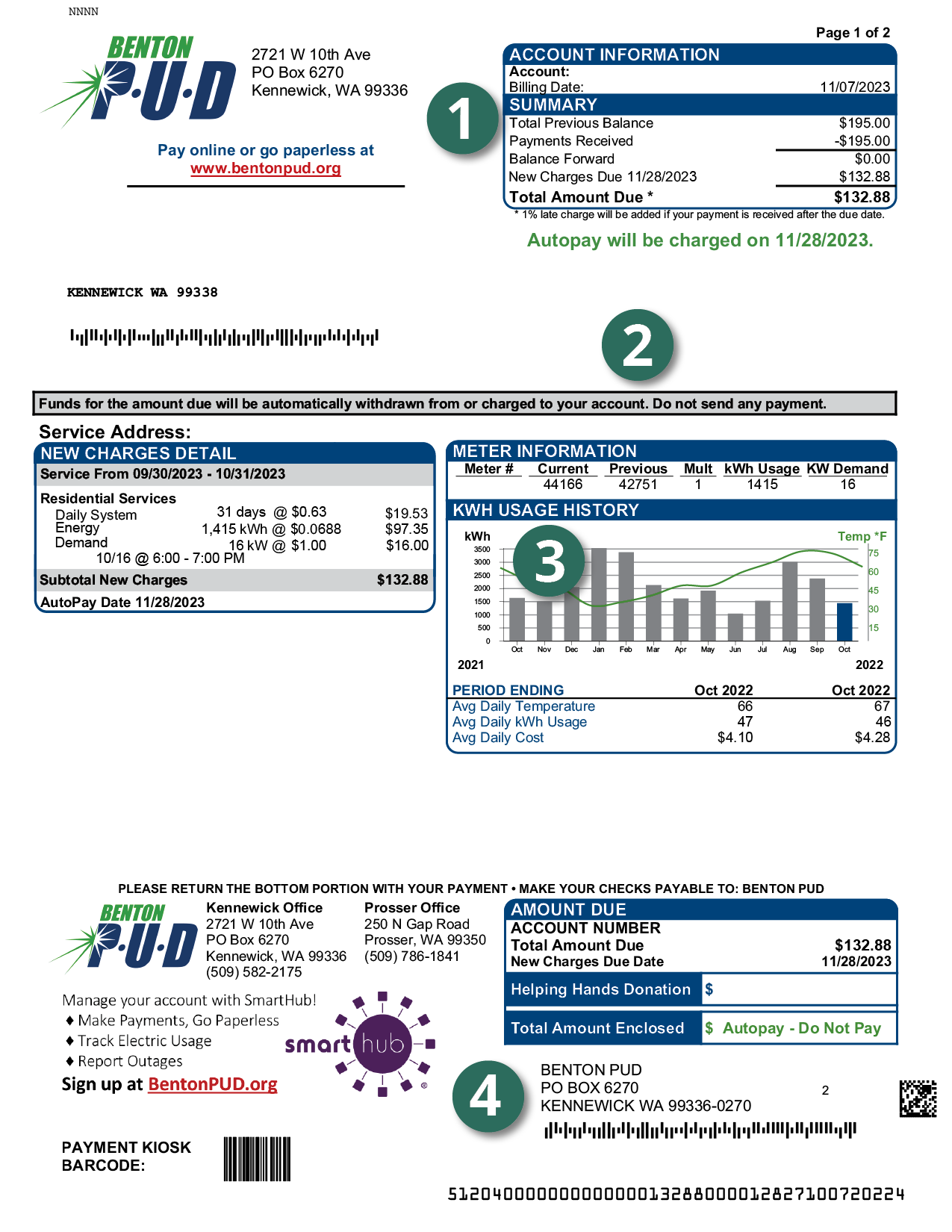How to Read Your Bill
1 - Account Details at a Glance
Your account number, amount due, due date, service period, and billing date are conveniently located at the top of your bill.
2 - Important Messages
Find messages and notifications from Benton PUD by reviewing this portion of your bill each month.
3 - Your Energy Usage Explained
See how much energy you've used in detail, including start and end readings and total kWh used. Compare your latest electric usage to each previous month's usage, going back a full year at that service location.
4 - Payment Stub
If you pay by mail, return this portion with your bill payment each month. Make sure the Benton PUD address shows through the return address envelope window.

Cost Calculator
In an effort to help our customers understand the costs associated with their monthly bill, the calculator below outlines the various cost components on a bill.
Select the appropriate rate class, insert the bill amount and it will calculate the costs for each category. An explanation for each numbered category is provided below.
Explanation of Costs
- Costs associated with efforts to maintain and improve fish runs, such as hatchery operations, fish habitat improvements, fish passage at dams, river habitat, etc.
- The opportunity cost of lost generation that occurs when water is released over dams to generate low cost hydropower. The Northwest Power and Conservation Council estimates that the Northwest loses 1,170 average megawatts each year from actions to aid fish migration, enough electricity to supply power to approximately 600,000 homes a year.
- Costs for transmitting power over the regional high voltage transmission infrastructure for delivery to our customers.
- Costs associated with the operation of Energy Northwest's Columbia Generating Station nuclear plant. A portion of the power generated by the plant serves customers of Benton PUD.
- Costs associated with the purchase of power from BPA to cover their cost (excludes Columbia Generating Station and fish and wildlife costs); such as operations and maintenance of power production facilities, energy scheduling, river management operations, etc.
- Cost of ancillary services related to scheduling, trading, risk management, etc.
- Cost of market purchases to meet load during certain times of the year.
- Cost of mandated conservation activities that are used to assist customers with energy efficiency improvements in their homes and businesses.
- Cost of renewable energy purchases from Nine Canyon and White Creek wind farms, net of sales for resale.
- Cost of renewable energy credit (REC) purchases.
- Revenue generated in the wholesale power market from the sale of surplus energy (excludes sales for resale associated with Nine Canyon, White Creek, and Frederickson). The revenue is used to lower rates for all of our customers.
- Costs to construct new distribution facilities (poles, wires, transformers, etc.) and upgrade existing facilities to deliver power to Benton PUD customers.
- Costs associated with the payment of principal and interest on amounts borrowed to finance capital projects including renewable energy sources. Benton PUD will periodically issue bonds to fund the construction of new distribution facilities and other equipment to operate the utility.
- Costs not related to the purchase and sale of wholesale power. Included within this category are costs associated with operations and maintenance, customer service and administration.
- Benton PUD is assessed taxes by the State of Washington on all kilowatt hour sales.
- Engineering fees, rental of transmission lines, and income from pole contacts, etc.
.png?lang=en-US)
.png?lang=en-US&ext=.png)